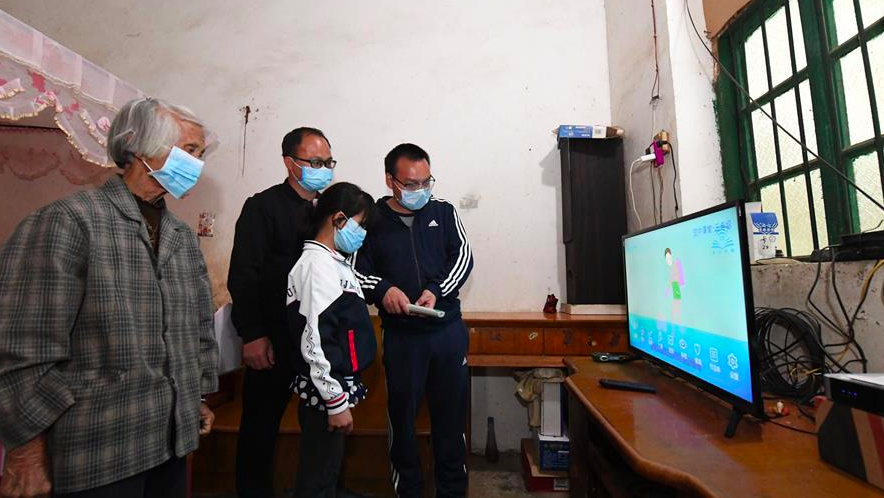
Huang Dihui does eye exercises following instructions of an online class on TV at Taiping Town, Wuming District of Nanning City, south China's Guangxi Zhuang Autonomous Region, March 12, 2020. /Xinhua
Editor's Note:
Eduardo Velez, Adjunct Professor, Georgetown University and Visiting Professor, Kobe University
Wang Yan, Senior Specialist, Director of Department for International Exchange, National Institute of Education Sciences
Chi Jin, Associate Professor at the Center for Teacher Education Research at Beijing Normal University
When education systems were plunged into an emergency as a result of the COVID-19 outbreak and many schools and universities closed, governments and education institutions resorted to online education to ensure that students' learning was not disrupted.
This may be effective for many, but certainly not for all. Low-income countries or regions are facing particular challenges that require special attention.
Forty years ago, with the first wave of artificial intelligence (AI), we expected new technology to improve access and quality of education in developing countries. The new technology brought about positive changes, but not miracles as some argue. In fact, it even increased education inequity in many parts of the world.
History repeats itself. Today, AI is, again, expected to be a change-maker in solving the challenges posed by COVID-19. But it all depend on resources and expertise that countries, education institutions and families can afford.
Today, with the modality of online learning adopted by many countries, it is fair to ask if all students benefit in the same way.A study of the World Bank focusing on Europe and Central Asia shows that well-off families can afford computers and other technologies that low-income families cannot. The latter may not even have internet access at home or in their neighborhoods. The digital gap is thus widening education inequity.
This corroborates evidence from earlier studies that schools in rural and remote areas remain marginalized regardless of technological progress and its application in education sector. While urban students in particular students from middle-class families can have home access to the cutting-edge technology, this may not be the case for students from low-income families everywhere.
Another important agent of change is school leaders (principals, headmistresses, headmasters) who oversee education production in school administration on daily basis.As in the context of the pandemic, there are many discussions about the implications for teachers, students and parents, not much about the principals though.
Practically speaking, the school leaders manage "innovations" in the education sector. The big elephant has been in the room for a long time. Unless their role is given full play, innovation won't take effect even with the advanced technologies.
Moreover, the private sector could play an instrumental role in using the new technology for education purposes.In the early 1980s, the Velez Group piloted Piaget's constructivism-based classroom teaching and school administration in rural and urban marginal areas of Colombia (with free personal computers provided by IBM). It proved that the technology did not improve quality though it had positive impact on non-cognitive achievement. The same thing has happened in other countries.
In the same vein, Papert and then Negroponte insisted that every student in the world could have access to the magic tool – the one-laptop-per-child computer to improve learning given the low cost of technology. The application of this approach has failed in several countries.
General policies may miss an important segment of the student population, mainly when we are supporting delivery of education services in an emergency situation like the outbreak of COVID-19. Focus/priorities should be set on those that are more vulnerable, who are often missed by new policy and new technologies. This would help governments achieve more, better and more equitable results.
At the beginning of coronavirus outbreak in China, students in rural and remote areas had difficulties continuing their learning due to a shortage of infrastructure or facilities.

Teachers instruct student Huang Yujuan on using an online class system on TV at Taiping Town, Wuming District of Nanning City, south China's Guangxi Zhuang Autonomous Region, March 12, 2020. (Xinhua/Lu Boan)
In mountainous areas, some teachers taught outdoors on the top of hills where they can access to better internet connectivity. To ensure students would not to be disrupted, the Ministry of Education soon established an online platform that could accommodate 50 million students learning simultaneously. For students in rural and remote areas, the government coordinated broadcasting of classes through television for primary and secondary students. The public and private sectors joined forces to improve learning facilities in poverty-stricken counties, such as providing iPads and other technological resources.
Indeed, now we have more information and more effective approaches to use the new technology that 40 years ago we could not.This will facilitate identification of the specific models to improve quality, but it won't take effect without awareness of differences within education systems, as well as a corresponding vision for targeted policies.
Otherwise, it will be likely that in rural and urban marginal areas, students would not be unable to learn how to read after the primary education cycle, as happened 40 years ago.
In particular, governments need to target programs to provide the most vulnerable children access to new technology; not only equipment but even connectivity for online education, as suggested by the World Bank study.
Paradoxically COVID-19 is a wakeup call – it gives us the opportunity to improve education for the ones that might have been neglected otherwise.
(If you want to contribute and have specific expertise, please contact us at [email protected].)
 简体中文
简体中文

